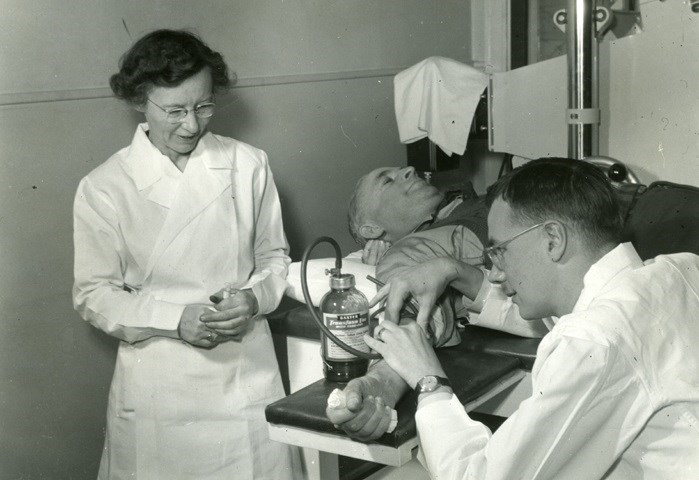From the archives of the Sault Ste. Marie Public Library:
The blood transfusion service began during the Second World War, when the Ontario Division of the Canadian Red Cross established a Blood Bank to meet the needs of wounded servicemen.
In Sault Ste. Marie, the Canadian Red Cross Blood Transfusion Clinic was established in May of 1943. This clinic was located at 208 Queen Street East and a rental fee of $60 a month was paid. A month later, the first blood donor clinic in Sault Ste. Marie, Ontario was conducted in June. The clinic was run under the supervision on Dr. Lillian McDonald and the Laboratory Technician Miss Elizabeth McNamara. Approximately 50 volunteers were required to fulfill positions including nursing, staff for the canteen and needle sharpeners.
Back in 1943, donors were required to eat fat-free meals for supper and breakfast. Approximately 450 c.c. of blood could be taken every two months. Withdrawing blood took five minutes, with a required resting period of 45 minutes after giving blood. Another “perk” of donating blood was that whiskey and cigarettes were given to donors, having been generously funded by local men’s service clubs.
Within six months of operation, 29 clinics produced 3,008 units of blood from 2,003 donors. Donors travelled from outside the city, including St. Joe’s Island, Bruce Mines and Thessalon by bus, free of charge.
With the ending of the war, the clinic closed its doors in July of 1945, but soon after the staff at the Provincial Health Laboratory directed by Dr. N. Graham, who was a strong supporter of the Red Cross, began a new service. In January 1946, using the Provincial Health Laboratory, fresh blood and plasma became available to the two local hospitals. The local Canadian Red Cross branch turned over all blood clinic records to the lab and continued to provide financial support to maintain the important service to the community.
At one time there was a charge of $15 per transfusion to the patient, or a requirement of two blood replacements from relatives or friends. By mid 1947, patients were no longer charged for blood transfusions, although patients and doctors were encouraged to find donors to replace the blood given.
In January 1948, the blood clinic moved to Wellington St. West, where a new Health Centre was established, adjacent to the former Steelton Public Library. At this time, Dr. C. Eaid became the physician-in-charge. Blood and plasma now became available to surrounding communities, such as Little Current, on Manitoulin Island, and Sault, Michigan. Blood from the Sault even on occasion travelled as far as Toronto and New York City.
The Sault Ste. Marie Branch of the Canadian Red Cross also sponsored Miss McNamara to attend a course on the RH blood factor in New York City. This testing for the RH factor was vital in saving the lives of babies and mothers.
By 1957, the blood donated at the clinic was being delivered directly to the hospital where it was stored and cross-matched by hospital personnel. In January 1960, the doors to the clinic closed for good. But just because the doors closed, it didn’t mean that the door closed on blood donations in the Sault. The Canadian Red Cross was evolving to be more efficient. Mobile technical units were better equipped to group and type blood and to supply certain types of blood where it was specifically needed. Numerous community clubs including the May Court Club, the Sooette Welfare Club, the Jaycettes and the Beta Sigma Phi who rounded up donors, became telephone canvassers, and provided refreshments during the blood donor clinics.
On May 24, 1960 the first mobile clinic came to the Sault. James McIntyre, the city’s mayor at the time, was the first donor at the new clinic. It was his 51st donation. Two hundred and ninety-six units were collected at St. Luke’s Hall and 343 units at Algoma Steel on May 24 and May 25, 1960.
The Sault Ste. Marie Canadian Red Cross branch has a long and proud history. In 1975, when it published “A Short History of the Sault Ste. Marie Branch of The Canadian Red Cross Society Sixty Years in the Life of Red Cross 1915 to 1975”, it acknowledged that “The same as now, fluctuation in the number of donors made necessary a continuous publicity campaign.”
Since 1998, blood donations in Canada are managed by Canadian Blood Services.
Each week, the Sault Ste. Marie Public Library and its Archives provides SooToday readers with a glimpse of the city’s past.
Find out more of what the Public Library has to offer at www.ssmpl.ca and look for more Remember This? columns here
